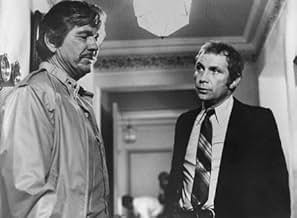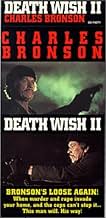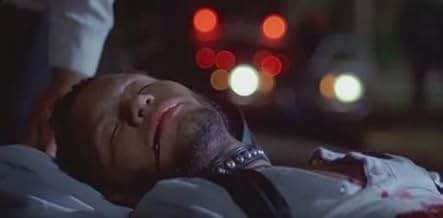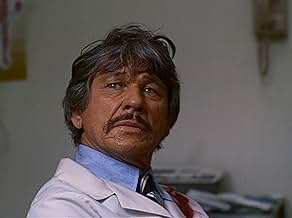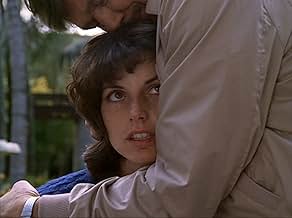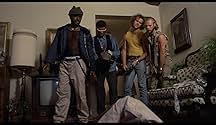El arquitecto Paul Kersey una vez más se convierte en un justiciero cuando intenta encontrar a los cinco punks callejeros que asesinaron a su hija y a su ama de llaves, esta vez en las oscur... Leer todoEl arquitecto Paul Kersey una vez más se convierte en un justiciero cuando intenta encontrar a los cinco punks callejeros que asesinaron a su hija y a su ama de llaves, esta vez en las oscuras calles de Los Ángeles.El arquitecto Paul Kersey una vez más se convierte en un justiciero cuando intenta encontrar a los cinco punks callejeros que asesinaron a su hija y a su ama de llaves, esta vez en las oscuras calles de Los Ángeles.
- Dirección
- Guionistas
- Elenco
- Premios
- 2 nominaciones en total
- Nirvana
- (as Thomas Duffy)
- Cutter
- (as Laurence Fishburne III)
- Dirección
- Guionistas
- Todo el elenco y el equipo
- Producción, taquilla y más en IMDbPro
Opiniones destacadas
Lady, you scream and disturb the neighbors, we'll cut you into little pieces and eat you for dinner!
We also get what I feel is the biggest collection of scumbags ever assembled. Thomas F. Duffy as Nirvana, Kevyn Major Howard as Stomper, Stuart K. Robinson as Jiver, Laurence Fishburne as Cutter, and E. Lamont Johnson as Punkut. It was fitting that the first kill occurred in a rat- infested building, and the last was an electrocution.
Vincent Gardenia is back to track down Kersey after he starts again in Los Angeles.
Unlike the serious and tragic first film, this is more focused and revenge-oriented. A good film, nonetheless.
None of Paul Kersey's (Charles Bronson) remaining family and friends get off lightly in this twisted nightmare of domestic violence, anal rape, vigilante justice and simplistic politics.
For fans of rough justice, the rape of Bronson's Mexican housemaid is truly amazing and eroticized like crazy by Winner's leering direction.
Thomas F. Duffy as Nirvana, the film's lead thug, is really horrible and a joy to behold (in a perverse way).
Led Zeppelin's Jimmy Page provides a rock score that scorches the L.A. imagery and Vincent Gardenia returns as the cop who prefers to look the other way.
A Cannon-backed sleazefest that brings home the groceries if you like eating trash.
Screw GONE WITH THE WIND. This is much more entertaining.
The main reason why the Death Wish series became increasingly ridiculous is the improbability of one man suffering so much bad luck. This time around a group of thugs break into Paul's home and gang rape his Latina maid. This scene is truly grim and more detailed than most of the more infamous "rape & revenge" movies of the 80s. The scene is particularly distasteful as poor Rosario gets roughed up so much worse than any other female victim in the series - all of whom happen to be white. Unfortunately, I don't think that it is a coincidence, as the entire Death Wish series had dubious racial undertones.
The action becomes increasing twisted when Paul's daughter, Carol, still traumatised from the attack in the original film, is kidnapped and raped. The nastiness of this act stems mostly from the creepy smile on Carol's face. When Carol is subsequently impaled on an iron gate, the transformation from the socially aware film of the 1970s to the sleazy, pure action of the 80s sequel is complete. This time around Paul doesn't even bother with the police, choosing instead to take all of the thugs out himself.
The second half of the film is fairly predictable and a bit slow in comparison with the downright nastiness of the opening half an hour. Paul walks around the streets of LA (he definitely gets around), shooting muggers, rapists and his daughter's attackers. This time around Paul doesn't hesitate shooting anyone and the conflict he demonstrated in the first film is nowhere to be seen. Instead, everyone from civilians to the police comment approvingly on his particular approach to crime control. Needless to say, Death Wish 2 is about as politically incorrect as they come and yet, endearingly of its time.
Michael Winner does a good job of capturing the atmosphere of early 80s LA, with amusing glimpses of religious fanatics, coke dealers and general crazies. The 80s fashion on display is pretty funny and the scene where the thugs dance to their "ghettoblaster" makes me laugh every time. The acting is highlighted by Jill Ireland's extraordinarily wooden turn as Paul's new girlfriend. Her ability to lower the tone of any Charles Bronson movie borders on the supernatural. Lastly, Jimmy Page's soundtrack deserves a mention, it is different to say the least.
If you are looking for cheap, nasty, morally corrupt entertainment, then you should enjoy Death Wish 2. I certainly did.
The first peculiarity is that much more strongly than the first film, Death Wish II's urban crime-ridden backdrop is exaggerated to a point of caricature. Of course, there was plenty of crime in Los Angeles during this era, but not as depicted here. This is almost Broadway-style crime, with choreographed gaggles of hoodlums running out of control in designer gang-wear, making spectacles of themselves. It's over the top but serious in a way that feels uncomfortable at first, but then, that's just the point, and it helps anchor the plot developments that follow.
And that plot should be no surprise to anyone who first watches Death Wish I. Death Wish II follows the plot of its predecessor as if it were a fairly rigid template. Even the events that cause Paul Kersey (Charles Bronson) to take charge and clean up society's scum by his lonesome are very similar. I don't see this as a flaw here (as I don't in many other sequels that use a template approach, including series like Friday the 13th). This is a direct continuation of the story of the first film, and the similarity gives Death Wish II both a natural, logical flow and a nice symmetrical structure.
Although Death Wish I had its brutal moments, Death Wish II amplifies that atmosphere and sustains it through its length. Like the films that best display gritty 1970s New York City--such as Taxi Driver (1976) and Basket Case (1982)--Death Wish II makes you feel almost dirty (in the grimy despair way, not a sexual way) while watching it. It's ironic, maybe, that Death Wish II does this so well when the setting is Los Angeles as opposed to actually being New York City, as in the first film. That director Michael Winner is able to perpetuate that atmosphere, whether by accident or design, results in the viewer being sucked into the setting and vicariously experiencing the range of unpleasant emotions felt by both the protagonists and the antagonists.
Also helping on that end is the score, provided by Led Zeppelin guitarist Jimmy Page. Although Winner sometimes incorporates Page's music in a discordant, jarring way--over the opening credits when it fights for volume with radio banter, for example--more often than not the score gives Death Wish II a sublime, otherworldly and eerie edge. It's too bad that Page didn't go on to score many more films.
This is certainly not a film to show during family time, and it's not particularly uplifting or overflowing with positive messages or socially redeeming values. But it's not trying to be any of those things. It's just a visceral (especially on an emotional level), disturbing revenge flick, and at that, it meets its goals well.
¿Sabías que…?
- TriviaAccording to Michael Winner's biography, Charles Bronson's alcoholic brother often visited the set to borrow money. Bronson was careful not to give him too much in case someone might kill him for it. He was later found dead in a cheap hotel room having been stabbed in the buttocks.
- ErroresKay tells Kersey he will wait three minutes before ringing the security alarm, yet he only waits about a minute or less.
- Citas
Paul Kersey: You believe in Jesus?
Stomper: Yes, I do.
Paul Kersey: Well, you're gonna meet him.
[Paul shoots Stomper dead]
- Versiones alternativasThe R-rated US release is heavily edited missing part of the rape scene of the maid and most of the rape scene of Kersey's daughter (and her graphic suicide). The uncut version is available on BluRay.
- ConexionesFeatured in Not for Women Only: Episode dated 15 February 1982 (1982)
- Bandas sonorasGo, Tell It on the Mountain
Traditional
Performed by the church congregation
Selecciones populares
Detalles
- Fecha de lanzamiento
- País de origen
- Idiomas
- También se conoce como
- Death Wish II
- Locaciones de filmación
- 1716 North Western Avenue, Los Ángeles, California, Estados Unidos(Pioneer Chicken where Paul Kersey stares at the punks)
- Productoras
- Ver más créditos de la compañía en IMDbPro
Taquilla
- Presupuesto
- USD 2,000,000 (estimado)
- Total en EE. UU. y Canadá
- USD 16,100,000
- Total a nivel mundial
- USD 16,100,000





